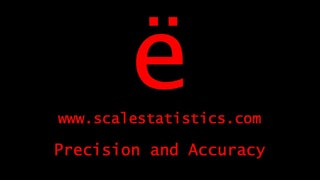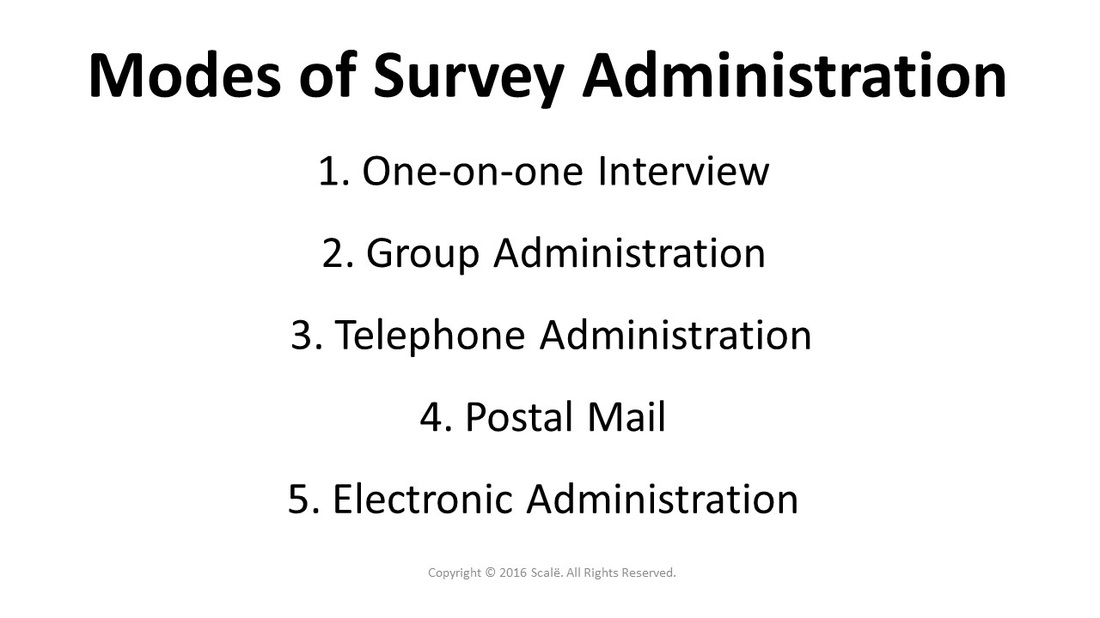Survey modes of administration
There are five ways to administer surveys
1. The one-on-one mode of administration is feasible when giving tests and psychological instruments. This method is very time-intensive but can yield thick and rich qualitative data related to the participant's cognitions, feelings, and behaviors. It is not suitable for gathering large amounts of data from a population.
2. Group administration is often employed in testing environments for instruments such as the ACT, SAT, GRE, MCAT, and others. This mode has the benefit of an immediate response rate and proctoring which can lead to stronger observations of the participants in their natural environment. There is also the increased sample size which is needed to conduct psychometric analyses. Measures must be taken by researchers to standardize the manner with which the survey instrument is administered to participants.
3. Telephone administration is by far the most taxing and archaic method for collecting survey data. The entire survey, including informed consent, instructions, items, responses, and demographic questions, has to be read to participants. A standardized script must also be used by the administrators while also attempting to establish a sense of rapport with participants. People also change phone numbers often and socially mobile populations may go unrepresented in the data analysis. Language barriers may exist as well. It is also not feasible for most types of surveys because questions must be limited for sake of time. If at all possible, it is best to avoid this mode of survey administration.
4. Postal mail administration is the most traditional method for collecting survey data. The United States Census Bureau collects data using postal mail, as does many commercial and non-commercial entities. There are the primary advantages of giving participants incentives for taking a survey and also allowing them to interact with something tangible. The primary disadvantage of this mode is that the researchers are putting a lot of faith into the potential participants to fill the survey out correctly AND mail it back upon completion.
Incentives are thought to cause "cognitive dissonance" in potential participants whereby their decision to take the incentive causes intrapsychic feelings of distress which will be alleviated by completing the survey. Also, there is the potential for surveys to be mailed to participants that do not meet criteria for inclusion in the study. Potential participants may also have moved since the mailing list was created.
5. Electronic (or email) administration is by far the most feasible, practical, and technologically savvy method for conducting survey research focused on gathering large amounts of population data. With the advent of the internet and email, this type of survey administration has become the "go-to" mode of administration for many researchers conducting cross-sectional studies. There are many online applications that will allow for researchers to publish their survey instruments along with a unique hyperlink that can be embedded into emails. Once potential participants click on the hyperlink, they will be taken to an online version of the survey which they can readily take on whatever kind of device they are working on.
The obvious advantage of this mode of administration is that researchers can access large numbers of participants with the click of one button. The primary disadvantage of this mode is that participants may simply delete the survey email because they have received so many of them in the past. Also, people may have deactivated their respective email address or may no longer be monitoring it. The survey may also be sent to individuals that do not meet inclusion criteria for the study. There is also the technology gap to be considered when using this mode of administration. Not all members of a population will have access to the technology needed to receive email, nor will everyone know how to use email and interact with an electronic device. This can lead to under-representation of these types of populations.
2. Group administration is often employed in testing environments for instruments such as the ACT, SAT, GRE, MCAT, and others. This mode has the benefit of an immediate response rate and proctoring which can lead to stronger observations of the participants in their natural environment. There is also the increased sample size which is needed to conduct psychometric analyses. Measures must be taken by researchers to standardize the manner with which the survey instrument is administered to participants.
3. Telephone administration is by far the most taxing and archaic method for collecting survey data. The entire survey, including informed consent, instructions, items, responses, and demographic questions, has to be read to participants. A standardized script must also be used by the administrators while also attempting to establish a sense of rapport with participants. People also change phone numbers often and socially mobile populations may go unrepresented in the data analysis. Language barriers may exist as well. It is also not feasible for most types of surveys because questions must be limited for sake of time. If at all possible, it is best to avoid this mode of survey administration.
4. Postal mail administration is the most traditional method for collecting survey data. The United States Census Bureau collects data using postal mail, as does many commercial and non-commercial entities. There are the primary advantages of giving participants incentives for taking a survey and also allowing them to interact with something tangible. The primary disadvantage of this mode is that the researchers are putting a lot of faith into the potential participants to fill the survey out correctly AND mail it back upon completion.
Incentives are thought to cause "cognitive dissonance" in potential participants whereby their decision to take the incentive causes intrapsychic feelings of distress which will be alleviated by completing the survey. Also, there is the potential for surveys to be mailed to participants that do not meet criteria for inclusion in the study. Potential participants may also have moved since the mailing list was created.
5. Electronic (or email) administration is by far the most feasible, practical, and technologically savvy method for conducting survey research focused on gathering large amounts of population data. With the advent of the internet and email, this type of survey administration has become the "go-to" mode of administration for many researchers conducting cross-sectional studies. There are many online applications that will allow for researchers to publish their survey instruments along with a unique hyperlink that can be embedded into emails. Once potential participants click on the hyperlink, they will be taken to an online version of the survey which they can readily take on whatever kind of device they are working on.
The obvious advantage of this mode of administration is that researchers can access large numbers of participants with the click of one button. The primary disadvantage of this mode is that participants may simply delete the survey email because they have received so many of them in the past. Also, people may have deactivated their respective email address or may no longer be monitoring it. The survey may also be sent to individuals that do not meet inclusion criteria for the study. There is also the technology gap to be considered when using this mode of administration. Not all members of a population will have access to the technology needed to receive email, nor will everyone know how to use email and interact with an electronic device. This can lead to under-representation of these types of populations.
Click on the Step 4: Writing Survey Items button to continue.
Hire A Statistician
DO YOU NEED TO HIRE A STATISTICIAN?
Eric Heidel, Ph.D., PStat will provide you with statistical consultation services for your research project at $100/hour. Secure checkout is available with Stripe, Venmo, Zelle, or PayPal.
- Statistical Analysis on any kind of project
- Dissertation and Thesis Projects
- DNP Capstone Projects
- Clinical Trials
- Analysis of Survey Data

